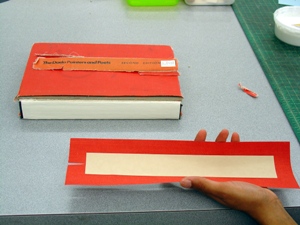Conservation Treatment Procedures
 Procedures performed in-house on circulating collections materials include:
Procedures performed in-house on circulating collections materials include:
Click on links to see examples of these treatments
- Pamphlet binders - These protect pamphlets and other small books from getting lost or damaged on the shelf or while circulating. Both paperbound books and pamphlets under 1/4" thick are treated in this manner.
- Double-fan adhesive binding – Damaged adhesive-bound books with wide inner margins can be re-bound in this flexible and durable binding style.
- Tipping in of loose pages and errata
- Reinforced covers - Paperbound volumes where the cover may have some artifactual or intellectual significance to the whole will have the covers stiffened from the inside.
- Spine repair - This is the most common repair needed on library books. Damaged cloth on the spine is removed and new cloth is added in its place. If possible, the original spine is re-used on the new, to preserve the title on the spine of the volume.
- Board attachments – These are done to re-attach one or both boards to an otherwise intact book.
- Leather binding repairs – For reasons of both conservation principle and economy, deteriorated leather bindings are often repaired with toned tissue rather than new leather. These repairs can include board attachment, spine repair, and general leather consolidation.
- Housing
- Portfolios - Books consisting of loose items, such as a music score, can be placed in a four-flap portfolio to keep all the parts together. Each item is labeled to keep it from becoming separated from the rest.
- Boxes – A variety of box types can be made to protect an item. Examples include cloth-covered clamshell boxes, phase boxes, and corrugated cardboard clamshell boxes.
For more information on these treatment procedures, contact Deborah Howe.